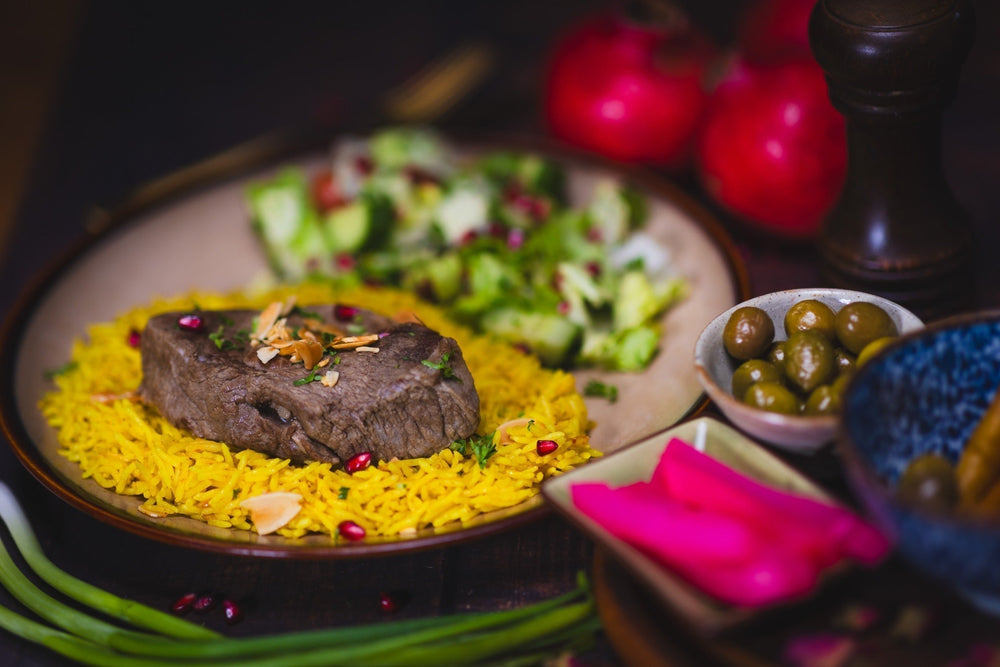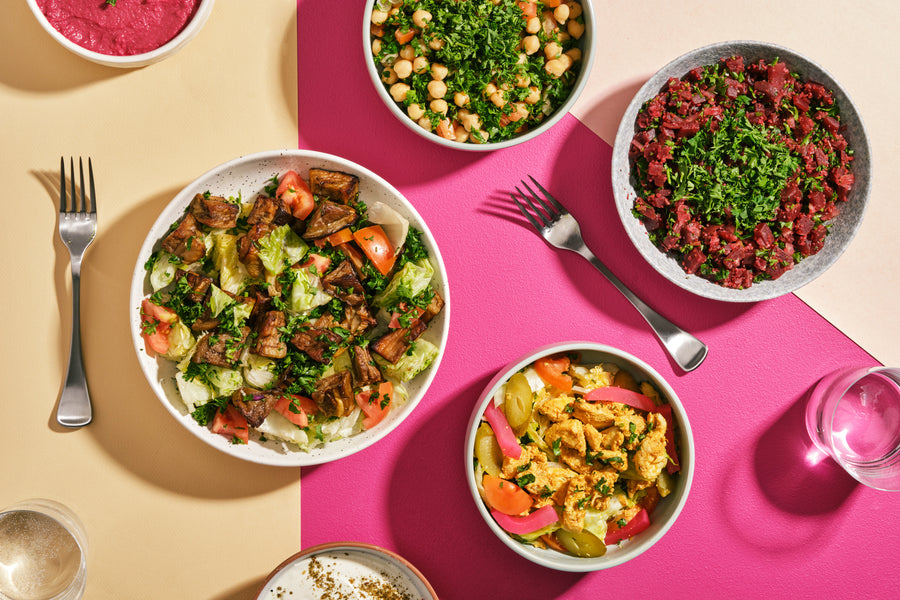All About the Rich Flavors and Traditions of Syrian Food: A Culinary Trip
Syrian food uses an unique blend of flavors and traditions that reflect its rich social background. With staple active ingredients like olive oil and garlic, along with a selection of seasonings, the dishes are both varied and inviting. From the detailed prep work of kibbeh to the sweet allure of baklava, each element of this culinary landscape exposes much deeper tales. As one explores the significance of these tastes, a greater understanding of common eating and celebration emerges.
The Essence of Syrian Components
The essence of Syrian ingredients hinges on their abundant diversity and ingrained cultural importance. Influenced by the country's varied geography and background, Syrian food incorporates a vast array of flavors, herbs, and fresh fruit and vegetables. Staples such as olive oil, garlic, and lemon supply a foundation, while flavors like coriander, sumac, and cumin add depth and complexity to dishes.The usage of fresh herbs, including parsley and mint, highlights the value of seasonal components. Additionally, the region's productive soil yields a wealth of fruits and vegetables, such as pomegranates, eggplants, and tomatoes, which are indispensable to lots of dishes. Grains like bulgur and rice create the base of many meals, highlighting the importance of these components in Syrian society. This blend of flavors shows not simply a culinary tradition but additionally a tapestry of historic influences, making Syrian components necessary to comprehending its cuisine's vivid personality.

Iconic Dishes of Syrian Food
Syrian food is renowned for its renowned recipes that display a rich tapestry of tastes and structures. Standard meze plates offer a variety of tiny dishes that entice the taste, while hearty main dishes supply satisfying focal points for dishes (Afternoon Tea Vancouver). To complete the experience, a selection of savory desserts adds a wonderful note to the cooking journey
Standard Meze Plates

Hearty Key Courses
Hearty primary courses work as the centerpiece of Syrian dining, showcasing a blend of tastes that reflect the country's abundant cooking customs. Dishes such as kebab hindi, featuring marinated lamb skewers, and the celebrated mujaddara, a soothing mix of lentils and rice, highlight the use of fragrant spices and fresh components. One more staple is the iconic kibbeh, made from bulgur wheat and minced meat, commonly served in different forms, consisting of baked, fried, or raw. In addition, the flavors of the land come alive in recipes like stuffed veggies, known as mahshi, which are full of rice, meat, and herbs. These main dishes not just please cravings however also tell tales of family gatherings and social heritage.
Delectable Treats Selection
A delightful variety of treats defines the sweet side of Syrian food, supplying a tantalizing end to any type of meal. Among the most celebrated confections are baklava, delicate layers of phyllo pastry loaded with nuts and soaked in syrup, and maamoul, shortbread-like cookies typically packed with days or nuts. Knafeh, a rich treat made from slim noodle-like bread soaked in syrup and layered with cheese, is a preferred choice, particularly throughout cheery occasions. Furthermore, the great smelling and pleasant rice pudding, referred to as roz bil laban, gives a calming coating. These delicious treats not just display the region's culinary proficiency however likewise show the cultural heritage of Syria, making them valued treats in both dining establishments and homes alike.
Traditional Cooking Strategies
Although contemporary eases have influenced many cooking techniques, standard food preparation techniques remain important to Syrian cuisine. These methods commonly emphasize making use of fresh, seasonal components and focus on slow-moving cooking to establish abundant tastes. Techniques such as barbecuing, braising, and stewing are common, enabling the all-natural tastes of the active ingredients to shine through.One notable method is the prep work of kibbeh, a dish made from carefully ground meat and bulgur. It needs experienced hand-rolling right into different shapes and can be baked, fried, or served raw. In addition, the art of making bread, specifically pita, is main to several his comment is here meals, commonly cooked in a conventional rock oven.Preservation approaches like pickling and fermenting also play an essential role, enhancing the diversity of flavors located in Syrian dishes. These strategies not only mirror the region's farming heritage but also foster a solid sense of neighborhood via shared cooking methods.

The Role of Spices in Flavor
Flavors function as the heart beat of Syrian cuisine, instilling recipes with complex flavors and fragrant depth. Each seasoning plays a pivotal duty, contributing not just to preference yet additionally to the social heritage of the area. Generally utilized spices consist of cumin, sumac, and coriander, each supplying a distinct account that elevates traditional dishes. For circumstances, cumin gives heat and earthiness, while sumac adds a zesty illumination, improving the general dish.Syrian cooks typically mix spices to create harmonious profiles, showing the intricate balance of flavors that specify the cuisine. The use of seasonings is not simply for seasoning; it also serves to protect food and boost its nutritional worth. This thoughtful consolidation highlights a deep understanding of the cookeries, where flavors come to be essential storytellers, communicating the rich background and diverse impacts that identify Syrian gastronomy. Inevitably, spices are crucial in crafting authentic and remarkable Syrian recipes.
Cheery customs and celebratory meals
Commemorative dishes in Syrian food are marked by conventional feast recipes that mirror the country's abundant culinary heritage. Special events typically entail one-of-a-kind routines that improve the communal experience of dining. These customs not only honor the significance of the occasions yet additionally strengthen domestic and cultural bonds.
Conventional Banquet Dishes
When families collect to celebrate substantial occasions in Syria, standard banquet dishes take spotlight, showcasing the rich cooking heritage of the region. These gatherings usually include dynamic platters of mezze, consisting of hummus, baba ghanoush, and tabbouleh, which work as delightful beginners. The major course normally highlights lamb or poultry, marinated and prepared to perfection, commonly gone along with by great smelling rice pilaf or bulgur. One of the most precious meals is maqlooba, a layered rice recipe with vegetables and meat, flipped inverted prior to serving. Sweets additionally play a vital duty, with baklava and knafeh providing a wonderful surface to the meal. Each recipe not just thrills the taste but likewise mirrors the ingrained customs and public spirit of Syrian society.
Unique Celebration Rituals
Special events in Syria are noted by rich rituals that link food and celebration, reflecting the cultural importance of communal events. Congratulatory dishes usually include standard recipes such as kibbeh, tabbouleh, and numerous barbequed meats, prepared with treatment and shared among household and pals. During spiritual vacations like Eid al-Fitr and Eid al-Adha, households collaborated to prepare special sweets like maamoul, signifying unity and pleasure. Wedding celebrations are particularly fancy, including multiple courses and vibrant screens image source of friendliness. These events are not merely concerning food; they incorporate dancing, storytelling, and songs, reinforcing social bonds and cultural heritage. With these routines, Syrians celebrate life's milestones, guaranteeing practices are given via generations, enhancing their culinary landscape.
The Relevance of Sharing and Area
Sharing meals is an essential facet of Syrian society, mirroring the ingrained values of neighborhood and link. In Syria, food is not simply sustenance but a way of bringing people with each other. Friends and families collect around the table to appreciate conventional dishes, cultivating bonds and developing long lasting memories. This public dining experience stresses friendliness, where hosts most likely to terrific sizes to assure every visitor really feels invited and nourished.The act of sharing food also symbolizes kindness and solidarity, enhancing social connections within neighborhoods and larger neighborhoods. During gatherings, it is common for individuals to offer each various other, showcasing a spirit of togetherness that goes beyond individuality. Parties, whether tiny or big, are often marked by the sharing of dishes, where diverse tastes and meals integrated, reflecting the rich tapestry of Syrian culture. As necessary, the value of sharing and area in Syrian food is not only a culinary practice yet a crucial social method.
A Cooking Exploration of Syrian Desserts
Typically outweighed by tasty meals, Syrian sugary foods hold a cherished location in the country's culinary heritage (Afternoon Tea Vancouver). These confections show the area's rich background, blending flavors and methods from different societies. Standard desserts like baklava, with its layers of phyllo pastry, nuts, and honey syrup, display the artistry involved in Syrian cooking. Ma'amoul, a shortbread-like cookie full of nuts or dates, is often gotten ready for festive celebrations, signifying hospitality and celebration.Another cherished pleasant is Knafeh, a pastry saturated in syrup and split with cheese or lotion, providing a delightful comparison of textures. Syrians likewise delight in a selection of fruit protects and syrups, typically offered with tea or as component of a larger spread during gatherings. These desserts not just satisfy the taste but also act as a bridge in between generations, preserving the practices and tales of Syrian society with each mouth-watering bite
Frequently Asked Questions
What Are the Wellness Benefits of Traditional Syrian Foods?
The health advantages of conventional Syrian foods consist of rich nutrients from fresh vegetables, beans, and entire grains. These components advertise you can look here heart health, enhance digestion, and supply important vitamins, adding to overall health and a well balanced diet regimen.
How Has Syrian Cuisine Evolved For Many Years?
Syrian food has actually evolved considerably, influenced by historical trade paths, social exchanges, and local schedule of components. Traditional recipes have incorporated modern flavors and techniques while preserving their rich heritage, showing a diverse cooking landscape.
Exist Vegetarian or Vegan Options in Syrian Cuisine?
Syrian cuisine provides various vegetarian and vegan choices, featuring meals like falafel, tabbouleh, and stuffed grape fallen leaves. These dishes highlight the area's rich farming heritage, showcasing fresh veggies, grains, and aromatic spices in lively combinations.
What Beverages Set Well With Syrian Recipes?
When thinking about drinks that match Syrian recipes, one may locate that mint tea, pomegranate, and ayran juice enhance the meal's tastes. Additionally, red a glass of wine often pairs well with the spices typically discovered in these foods.
Exactly How Can I Recreate Syrian Dishes in the house?
To recreate Syrian dishes in your home, one must explore authentic dishes, collect conventional active ingredients, and make use of food preparation techniques distinct to the cuisine. Explore spices and discussion also boosts the general dining experience. Syrian cuisine is renowned for its iconic dishes that showcase a rich tapestry of appearances and tastes. Spices serve as the heart beat of Syrian food, infusing recipes with intricate flavors and aromatic deepness. Celebratory meals in Syrian cuisine are noted by standard feast recipes that mirror the country's abundant cooking heritage. Celebrations, whether small or huge, are commonly marked by the sharing of dishes, where diverse tastes and recipes come together, showing the abundant tapestry of Syrian society. Syrian food offers numerous vegan and vegan options, featuring recipes like falafel, tabbouleh, and packed grape leaves.